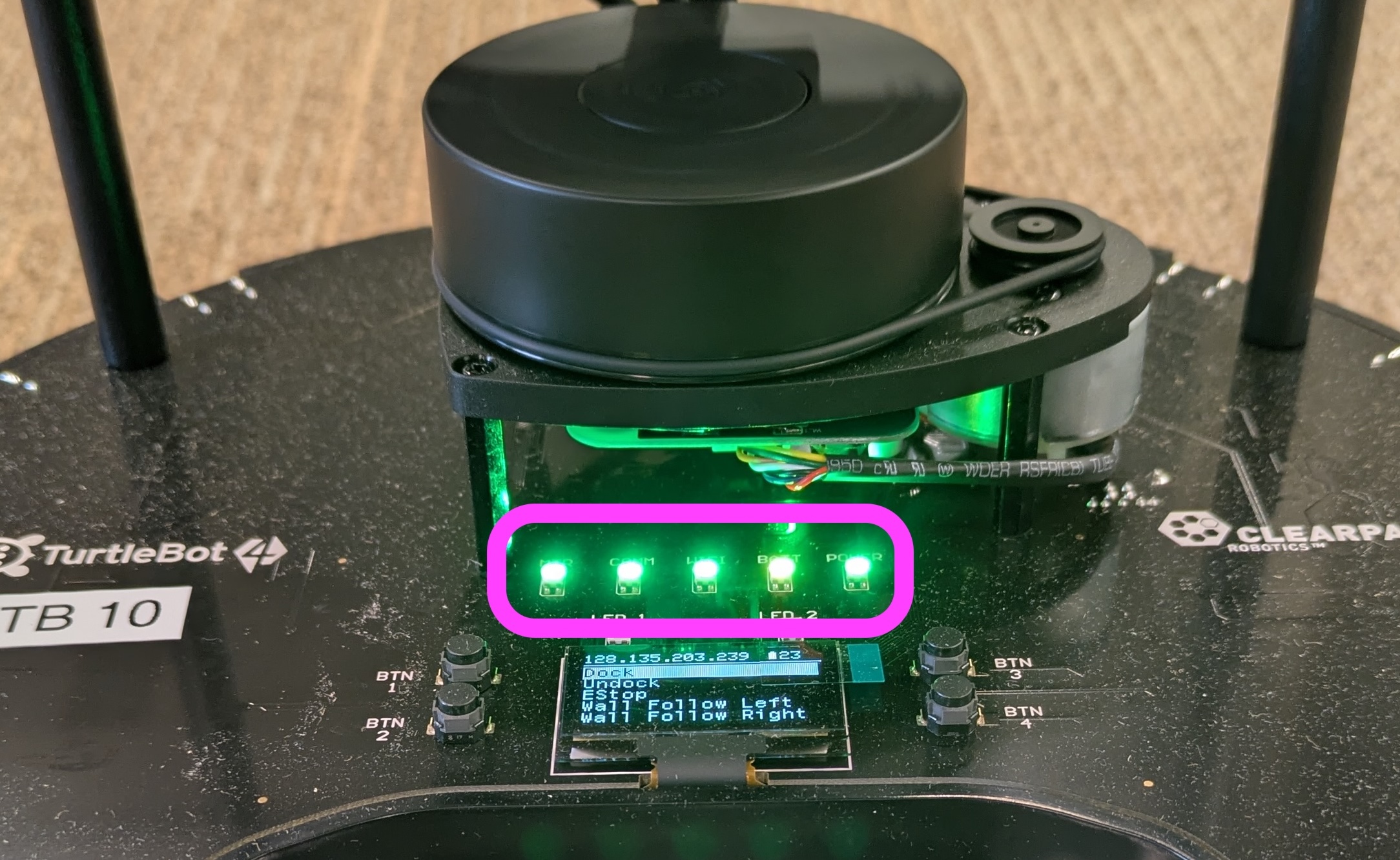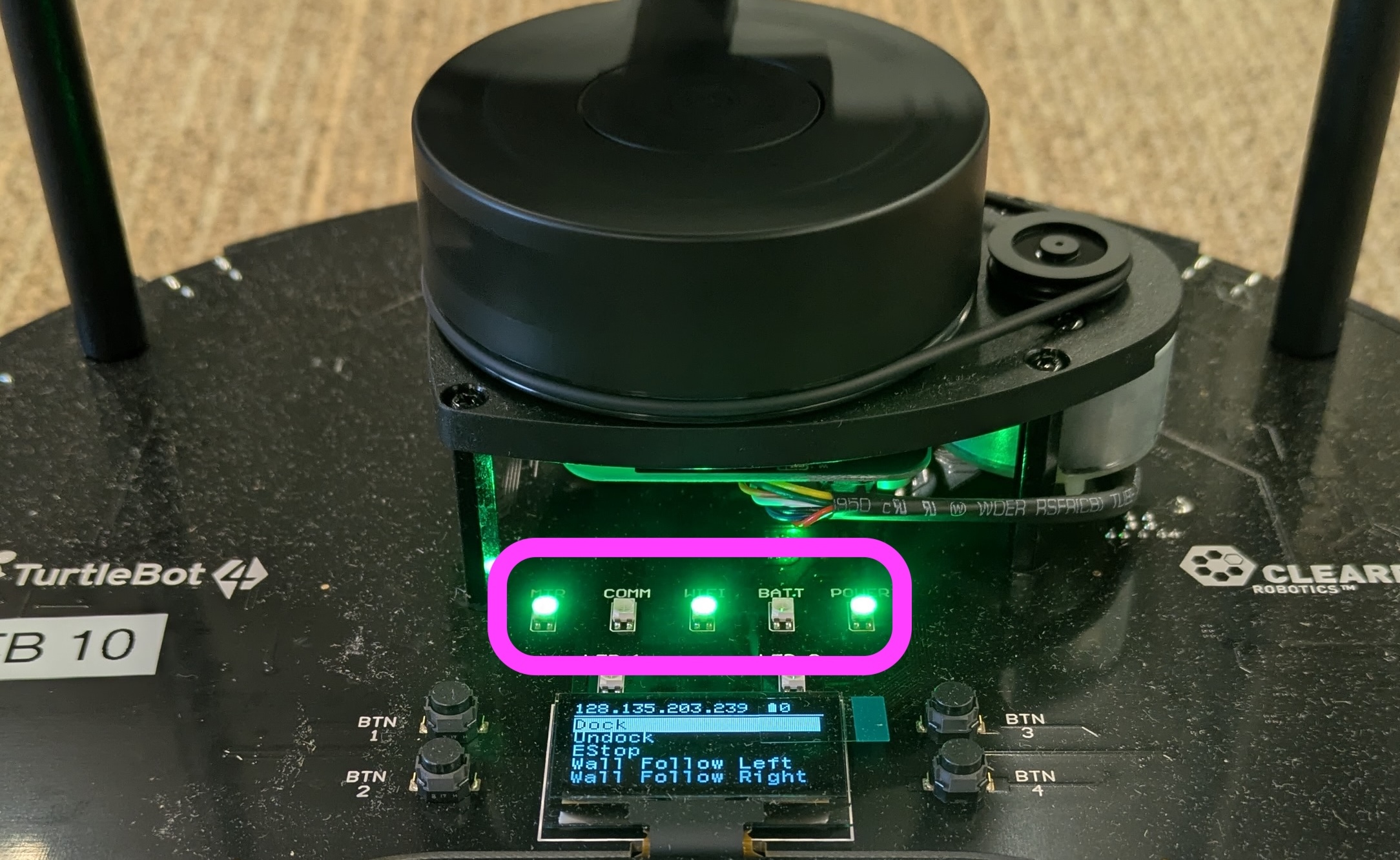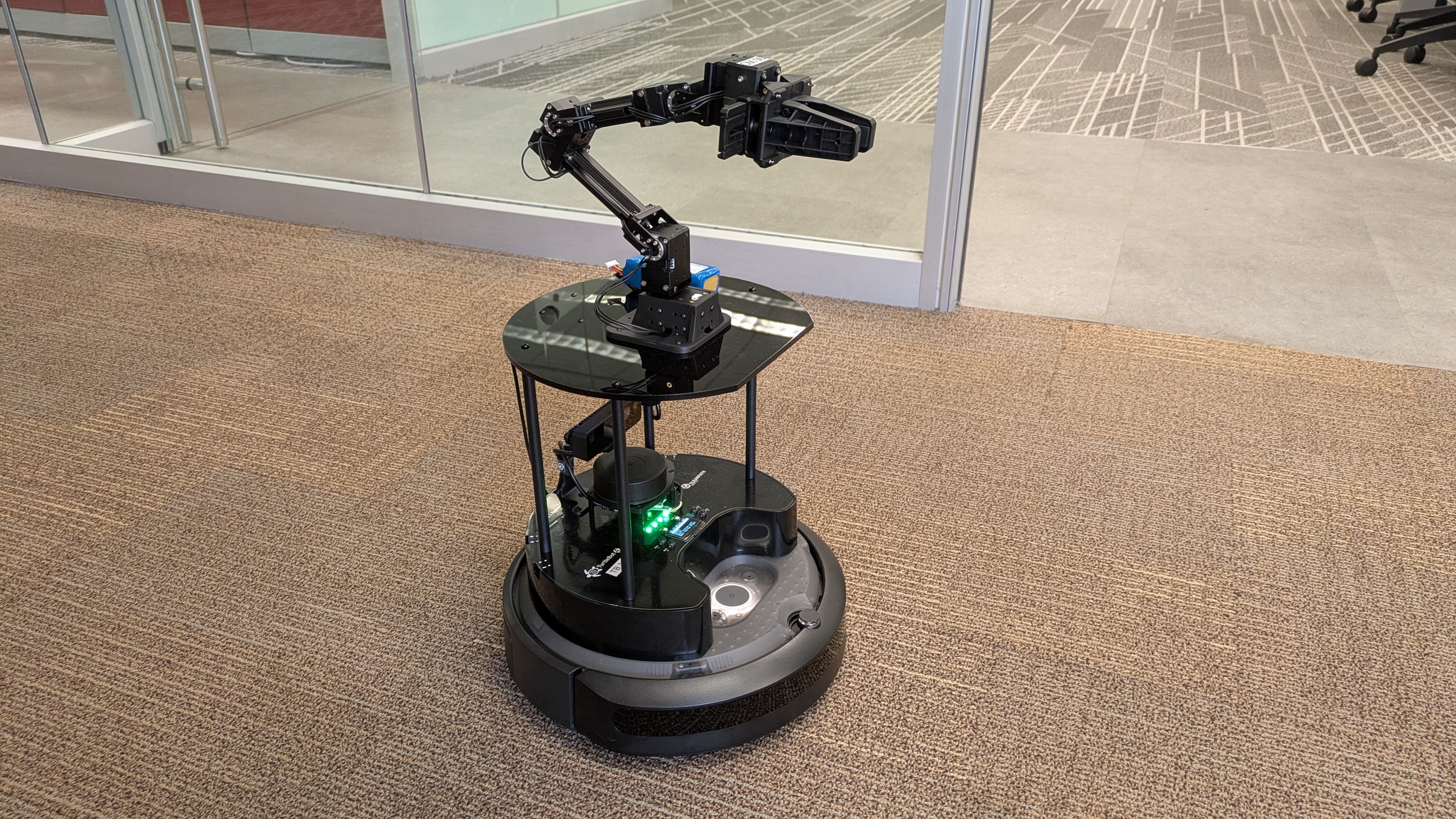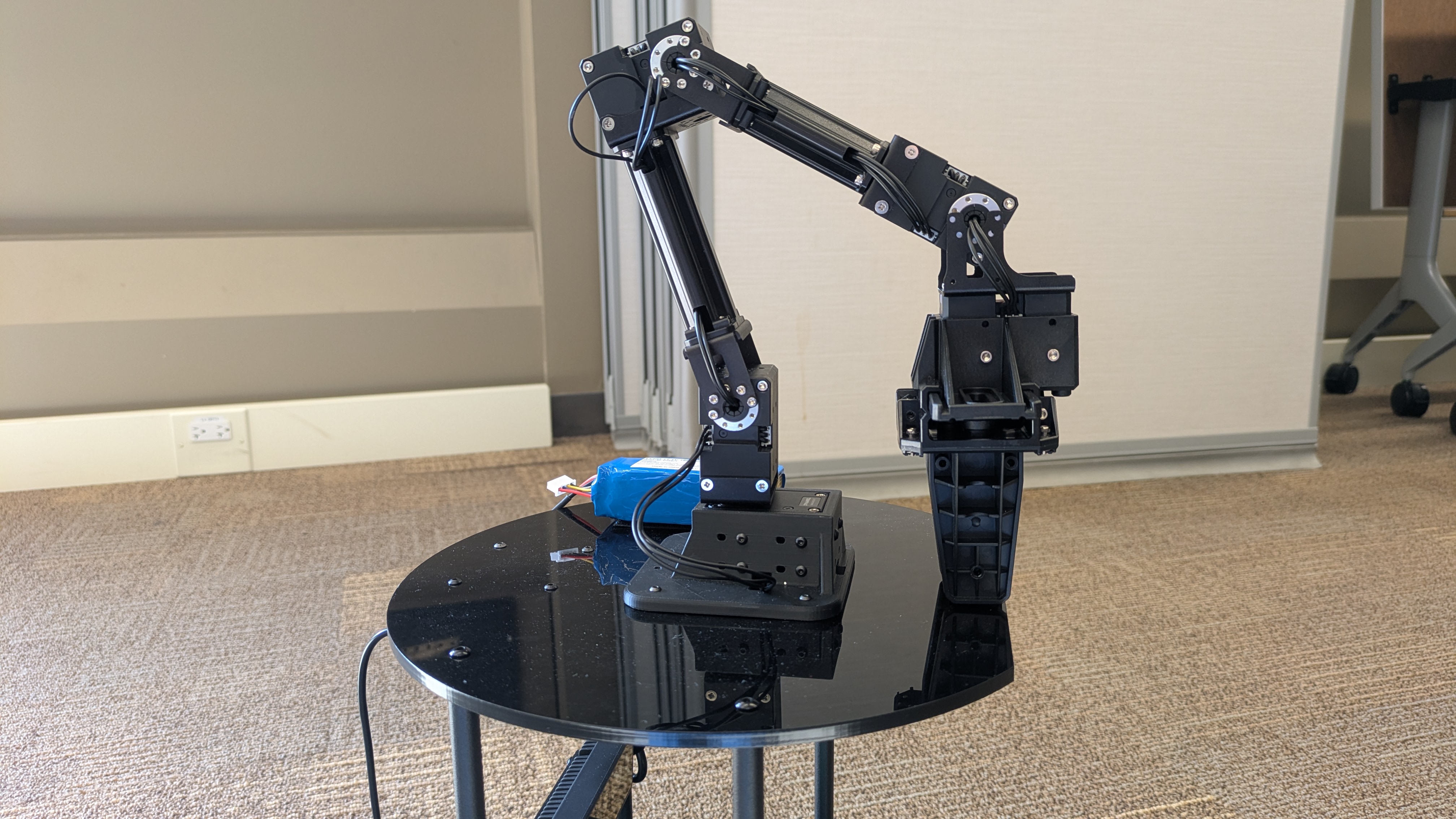Working with Physical Turtlebots
These are instructions for running ROS code on a physical Turtlebot4 in the John Crerar Library.
Handy Links
- Turtlebot Hardware Status Spreadsheet: This spreadsheet contains the current hardware status of the Turtlebots and OpenManipulator arms. If any of the class hardware is not working or acting funny, please make a note of it in this spreadsheet.
Overview
Each Turtlebot4 has two main components (1) an iRobot Create base and (2) a RaspberryPi. The RaspberryPi is connected to and controls the robot's sensors and arm and is the main interface between the user PC and the Create base. We have configured the Turtlebot4 robots with the Discovery Server network protocol.
Connecting to Turtlebot4
1. Turn On the Robot and Wait for Boot Completion
To start the robot boot process, pick up the Turtlebot4 robot by its base and place it on a charger. The robot should power on automatically. WAIT for the robot to finish its boot process before trying to connect - it should take about 2.5 minutes and the robot will make a "chime" noise once the boot process is complete.
2. WiFi Network Connection for Your PC
You will need to ensure your computer is connected to the correct wifi network:
- If you are using NoMachine to connect with a virtual CSIL5 machine: You can be connected with any available wireless network. We recommend connecting to
eduroamfor best performance. - If you are using any other computer setup (ROS2 on Mac/Windows, Ubuntu 22.04 partition/OS, VirtualBox VM):
Connect to the
intro_robowifi network (ask teaching team for the network password).
3. Environment Variable Setup
Next, you'll have to setup some environment variables to establish communication between your PC and the specific robot you wish to control: ROS_DOMAIN_ID, ROS_DISCOVERY_SERVER, and ROS_LOCALHOST_ONLY.
-
Robot number: Specify which robot you want to connect to:
The$ set_robot_num [robot-num]set_robot_numbash function is one that we wrote to automatically set theROS_DISCOVERY_SERVERto the IP address of the desired robot and to setROS_DOMAIN_IDto the number of the robot.Note: A few things to keep in mind with set_robot_num:- Checking current robot ID: If you want to check the current robot number you have saved in your environment variable settings you can run:
$ echo $ROS_DOMAIN_ID - Saved default: Your computer will save the last robot number you connected to, so be careful to check and reset the robot number each time you start working with a new robot. If you're curious, you can find the currently saved settings in
~/intro_robo_ws/src/intro_robo/intro_robo_utils/discover_server_env_variables.shwhich is sourced in your.bashrcfile.
- Checking current robot ID: If you want to check the current robot number you have saved in your environment variable settings you can run:
-
ROS_LOCALHOST_ONLY: If you're working with Gazebo and the simulated Turtlebot4, you'll want to set
ROS_LOCALHOST_ONLY=1, otherwise, if you're using the physical Turtlebot4 robot, you'll wantROS_LOCALHOST_ONLY=0. You can change this variable by editing your.bashrcfile:
After editing it to set$ nano ~/.bashrcROS_LOCALHOST_ONLYto your desired value, source the.bashrcso your changes take effect:$ source ~/.bashrc
4. Check Turtlebot4 Create Base Connectivity
In order to work properly, your Turtlebot4 it needs to have established a connection between its RaspberryPi and Create base. To check to make sure everything is working correctly, check the 5 LEDs on the robot. All 5 LEDs should be green. If the COMM and BATT lights are off, you'll need to reboot the RaspberryPi to properly establish a connection with the Create base.

If all 5 LEDs are green, you're all set and can continue to the next step!

If the COMM and BATT LEDs are off, you'll need to reboot the RaspberryPi to re-establish a connection with the Create base. First SSH into the robot (password: turtlebot4)
$ ssh ubuntu@$ROBOT_IP$ sudo reboot5. Test Your Connection
There are a few different ways to test your computer's connection to your specific Turtlebot4. Here are a few options:
-
List ROS2 topics: Run ros2 topic list in your terminal once the robot is fully turned on (you hear the Chime noise and all 5 green LEDs are on). You should see a long list of ROS2 topics all starting with
/tb11, for example, if you're trying to connect to Turtlebot 11. -
Publish movement commands via the terminal: You can publish ROS2 messages directly to the terminal using the command below. This command will move the robot forward, so ensure the robot is off the charger. Remember to replace the robot number in the ROS2 topic name (
tb11below) with the one that you're currently working with:$ ros2 topic pub /tb11/cmd_vel geometry_msgs/msg/Twist \ "linear: x: 1.0 y: 0.0 z: 0.0 angular: x: 0.0 y: 0.0 z: 0.0"
Remote Control Teleoperation of Turtlebot4
TODO
Operating the OpenManipulatorX Arm

Unlike the Turtlebot4, the OpenManipulatorX arm does not automatically start publishing and subscribing to ROS2 topics as soon as it turns on. You'll have to run the bringup code for the arm and start up MoveIt! every time you want to work with it. Follow the steps below:
- Check Battery: Ensure that a fully charged battery is plugged into the U2D2 board on the top plate of the robot.
-
Position the Arm: Position the arm as shown in the picture below to enable the arm to initialize properly. If you fail to do this, you may find that any movement command you send to the arm will fail.

-
[Terminal #1] SSH into the robot (password:
turtlebot4), check USB port number, and run bringup:
After running sudo dmesg | grep ttyUSB look for which USB port the$ set_robot_num [robot_num] $ ssh ubuntu@$ROBOT_IP $ sudo dmesg | grep ttyUSBFTDI USB Serial Deviceis connected to, it should be eitherttyUSB0orttyUSB1. Now run the bringup command for the arm by specifying the USB port you identified in the prior step.$ bringup_arm port_name:=/dev/ttyUSB1Note:bringup_armis an alias for the commandros2 launch open_manipulator_x_bringup hardware.launch.py. -
[Terminal #2] SSH into the robot and start MoveIt!: In a separate second terminal, ssh into the robot and start MoveIt!.
$ ssh ubuntu@$ROBOT_IP $ start_moveitNote:start_moveitis an alias for the commandros2 launch open_manipulator_x_moveit_config move_group.launch.py. -
[Terminal #3] Control the robot from your PC: You have several options here:
-
For the OpenManipulatorX GUI:
$ ros2 launch open_manipulator_x_gui open_manipulator_x_gui.launch.py -
For running code:
$ ros2 run [package-name] [file-name]
-
For the OpenManipulatorX GUI: